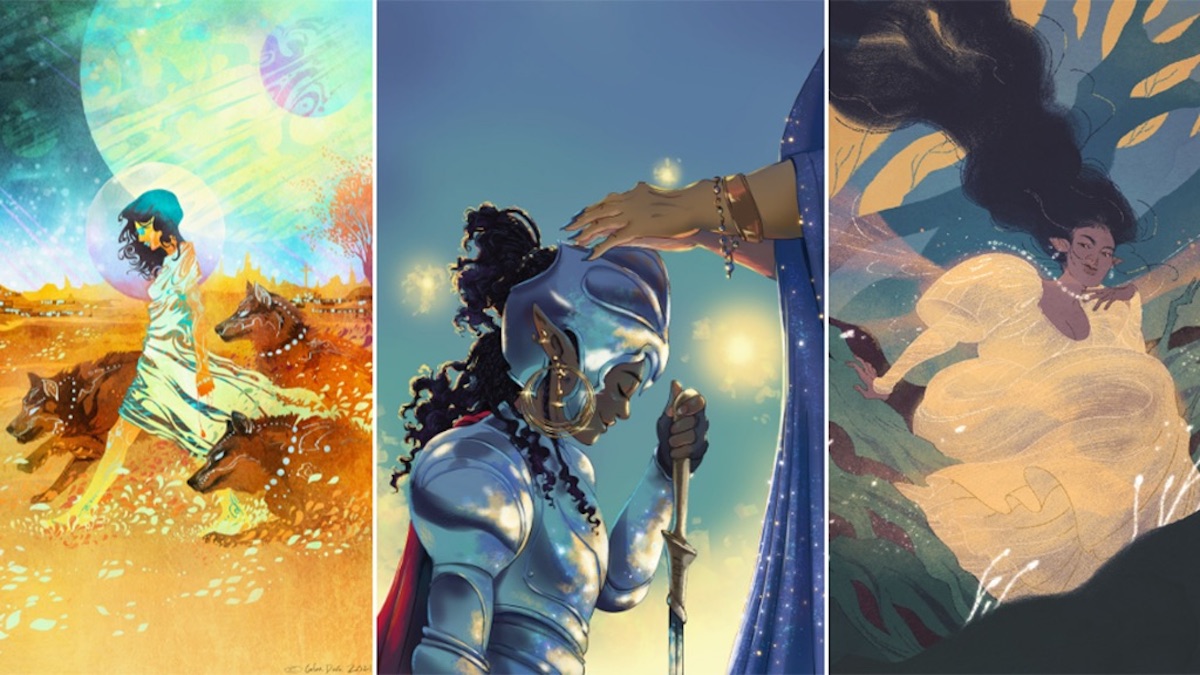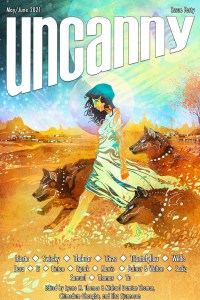In Our Fashion: Your Uncanny Guide to the Cosmos’s Best SFF Couture


As Uncanny Magazine opens up to fiction submissions during our Year Eight: Fly to the Future, Space Unicorns Kickstarter, I’m often asked as Co-Editor-in-Chief what I’m looking for in stories. Though there are lots of things that I adore once I read them, I must admit a particular weakness.
I’m easy for a good frock. I love stories that revolve around clothing, fashion, and how we use them to become, to reinvent ourselves, and to navigate the world around us.
Fashion and clothing in any given storytelling universe is an excellent venue for worldbuilding, since the ways that clothing is constructed, worn, sourced, created, and designed tell us about the climate, travel mechanisms, levels of industrialization, class and social statuses, values, and aesthetic senses of that world through the description of a drape of fabric, an approach to a cut, a level of detail in the sewing, and the reception of the clothing.
Characters of course require clothing to navigate the elements of their settings, but fashion can also be art in itself: uplifting, complex, challenging, sinister, or playful, depending upon how it is described, used, and how it might affect the story. What characters wear tell us about their personalities, their moods, their fears, their hopes, and their memories.
Fashion has become so integral to science fiction and fantasy that it’s impossible to walk a convention floor without seeing a dazzling display of the fabulous design and costuming choices from dozens of media properties, comics, anime, and books. Fashion and self-presentation are deeply personal methods of self-expression, even when the items worn are mass-produced. A piece of jewelry can represent love, commitment, challenges, or loss, depending upon how it was acquired and from whom. A particular pair of shoes can reflect feeling powerful, or swift, or fragile.
Fashion and design elements can signal our geekdoms and communities to other members. How we dress often reflects our internal state—or the one we wish to project. In the 1990s, I signaled my queerness to other members of the queer community through wearing rainbow freedom rings, having a particular haircut, and wearing overalls.
These days, I’m more of a stealth cosplayer. While I joke that my aesthetic now is more “starring in a 1950s MGM Technicolor musical,” my geeky side is often layered into that look. The Regency wedding gown I wore for my vow renewal was handmade as a gift from my best friend and matron of honor, who knew my deep love for Jane Austen. I wore Peggy Carter’s shade of lipstick to my last job interview to remind myself of my value. My TARDIS key necklace often makes an appearance during the beginning of an adventure or project, or when I travel. When I need to feel brave, I ask myself what River Song would wear, and try to imitate that. When I leave the house, I put on a leather jacket like armor, and try to channel my inner Jessica Jones, though it reads more as Amy Poehler’s “cool mom” from Mean Girls these days.
We have been watching a lot of early and pre-code films during the pandemic, and I very quickly developed strong feelings about costuming. I automatically assume I will enjoy the film more if I note Adrian, Orry-Kelly, or Edith Head are in charge of costuming during the opening credits. Listeners of the Verity! Doctor Who Podcast (of which I’m a cast member) already know that I am more than happy to spend lots of time discussing the costuming in Doctor Who, whether it’s a spot-on historical reproduction, or a zany approach to creating futuristic fashion. Often, the failures of imagination—or budget— are the most interesting to pick apart, because they inscribe the space between the designer’s ambitions and their actual resources.
When stories submitted to Uncanny emphasize fashion and clothing, I get excited. Sometimes it telegraphs the emotional states of the characters as they experience life changes. Ellen Klages’s “Nice Things” hinges on a string of pearls. In Lee Mandelo’s “The Span of His Wrist,” Cissy can feel and experience the emotions and experiences still clinging to the clothing she touches in the thrift store—the contentment of a beloved silk robe, the tenderness of a pair of designer shoes gifted by a lover on a tropical vacation. Similarly, in Meg Elison’s “Dresses Like White Elephants,” wedding dresses are imbued with the journey of both the maker and the wearer, and their stories are passed through physical connection. Both stories explore the act of letting go when the imbued items are passed to a new person.
Membership in particular communities is expressed through character dress. In Maurice Broaddus’s “The Ache of Home,” how characters dress indicates whether they are part of Celeste’s neighborhood or come from outside it. Christopher Caldwell uses Davion’s style to signal his queerness in “Femme and Sundance;” once Davion and Thomas get together, they dress carefully in designer cowboy finery before committing their first bank robbery.
Fashion and design can also reveal social changes over time. Mariko marvels at the significant shifts in fashion over decades from corsetry to flappers, and revels in her newfound freedom of movement in Caroline M. Yoachim’s “Colors of the Immortal Palette.” Delia Sherman’s “At Cooney’s” uses changing fashions to tell us where we are as Ali time travels.
And, of course, fashion can be deadly. Tansy Rayner Roberts outlines some of the deadliest historical fashions in her “Deadly Frocks and Murder Clothes” essay, including arsenic-laced dresses. Fictionally, Fran Wilde’s “Unseelie Brothers, Ltd.” demonstrates why one must must carefully select one’s gown for the Season when it’s made by a fae couturier who appears and disappears without warning. The cost can be much higher than anticipated, and goes well beyond money.
Sometimes, though, design and fashion are simply there for imaginative expression. Brother in T. Kingfisher’s “Metal Like Blood in the Dark” gives himself wings on a whim. Arkady Martine’s The Hydraulic Emperor blends science fiction, film history, and fashion and design to tell the tale of a lost filmmaker’s work. It’s easy to imagine Computron moving into cosplay as another aspect of expressing their fandom in Vina Jie-Min Prasad’s “Fandom for Robots.”
Humans imbue value and meaning into the things we wear, and the stories we tell about them. While the old saying is “clothes make the man,” I’d argue that clothing can make the story, often pulling it in new and interesting directions. I hope that the examples here provide a glimpse into how the stories published in Uncanny Magazine attempt to do it with style.

At Uncanny Magazine, we’re very proud of the stories, essays, poetry, and cover art that we’ve published in our first seven years. Not all of them focus on clothing as a storytelling mode, but we hope that this small sample of the works that do so will encourage you to check out our Uncanny Magazine Year 8: Fly to the Future, Space Unicorns! Kickstarter and join the Space Unicorn Ranger Corps. We have lots of swag, signed books, unique experiences, and of course access to the next year of Uncanny to check out.
—

Nine-time Hugo Award winner Lynne M. Thomas is the Co-Editor-in-Chief and Co-Publisher of the five-time Hugo Award-winning Uncanny Magazine with her husband Michael Damian Thomas. The former Editor-in-Chief of Apex Magazine (2011-2013), she co-edited the Hugo Award-winning Chicks Dig Time Lords, as well as Whedonistas and Chicks Dig Comics. She moderated the Hugo-Award winning SF Squeecast and contributes to the Verity! Podcast. In her day job, she is the Head of the Rare Book and Manuscript Library and Juanita J. and Robert E. Simpson Rare Book and Manuscript Professor at the University of Illinois at Urbana-Champaign, one of the largest public university rare book collections in the country. You can learn more about her shenanigans at lynnemthomas.com.
Want more stories like this? Become a subscriber and support the site!
—The Mary Sue has a strict comment policy that forbids, but is not limited to, personal insults toward anyone, hate speech, and trolling.—
Have a tip we should know? [email protected]
